Design Thinking is Dead. Long Live Design

Design is a whole brain exercise. An exercise that young designers may be missing in today’s factory system of design.
Confession
I believe the attention to design thinking isn’t without merit. Companies everywhere are becoming aware of the power that design offers business. There are a lot of success stories about design-led organizations. Wouldn’t it be great if your company could have a little of that, too? Well, of course it can, but to make it less scary and easier to pay for, we’ll call it design thinking.
The term design thinking has sunk to the level of corporate speak and simultaneously created the factory system of design. The problem with separating it from the holistic process of design is that you are selling yourself short. By limiting design to a station on the factory line, you ignore what can be learned through the act of design. To be successful, creative work is both a thoughtful and messy process.
The Design Process
Over the years, I’ve looked at many charts that outline different versions of the design process. They always look very organized and linear—usually some sort of progressive funnel from left to right. I’ve always admired these but knew that they weren’t real. It’s the tidy version we show the world to prove we are rational beings and worthy of your work and trust. Well, it’s time to come clean.
The real design process looks more like a plate of spaghetti. It’s a heaping pile of starts and stops. There are many entry points depending on the project. There are many people making it and eating it. There are meatballs that you either need to dodge, go over, under or, God forbid, go through. There are surprises in the marinara sauce. The list goes on and on. The part of the process charts that I will agree is true is that they have a beginning, middle and end. What we designers don’t admit often enough is that to do it right, the creative process is messy. There is a lot of back and forth to test and retest design thinking against the execution of design. In this work, there are unknowns when you start that are discovered through collaborations, inspiration, direct action or even serendipity.
I see this new factory system of design as robbing designers of this process. It leaves designers wholly unprepared to enter into such a fluid system. If spaghetti is too strange, then maybe improv or jazz is a better analogy. You must practice the entire range of an art form so that it becomes second nature. That is when the artfulness can be unleashed.
Rise of the Machines
One of my least favorite questions that I get in new business meetings is “what’s your specialty?” For one thing, we named our studio Hybrid, which should be a good indicator that we don’t like to specialize. I tell people that we don’t because it’s boring. It leads to repetition and sameness and that’s not why I got into design. The range of work and the duality of process makes our work better and constantly pushes us to improve.
The more I see young designers enter the factory system of design, the less progress I see. I see less creativity and truly less happiness. People need to feel like they are learning something new. Learning involves thinking. Without thinking, we are just a pair of hands and soon thereafter, a filter or program will do the executing for us.
Design Led Companies
I’ve had the luxury of working for and with some incredible companies over the years. The difference between these companies and others is that design isn’t just a segmented outline or process, it is a way of working. It is an action that affects every part of the business and especially every consumer experience. The level of excellence is over the top and it’s constantly setting a new standard for outstanding work. Nothing is phoned in. And nothing is ever good enough—not internal presentations, not anything. Ideas are everywhere. Anything is possible and excellence is everywhere. This kind of output doesn’t just happen. It’s part of a company’s culture to be flexible, agile, responsive, competitive and adaptable. Change is constant. They empower their people and are crystal clear on their purpose.
The Future is Human
As long as our audience has a beating heart, the future is human. The work that we do needs to touch the senses. It needs to be emotional and it needs to make people feel something. This level of connection doesn’t come from a factory. To move design forward and to give young designers a chance at career-long happiness, we need to marry the thoughtful with the messy. We don’t need design thinking, we need thinking designers. Long live spaghetti.
This article was originally published in Issue 11 of the Mohawk Maker Quarterly. The Mohawk Maker Quarterly is a vehicle to support a community of like-minded makers. Content focuses on stories of small manufacturers, artisans, printers, designers, and artists who are making their way in the midst of the digital revolution. Learn more about the quarterly here.
Suggested Articles
As digital printing evolves from compromise to sophisticated tool—advances in color, texture, and fiber papers push the boundaries of what's possible.
In today's competitive marketplace, packaging plays a crucial role in brand perception and consumer satisfaction.
Mohawk Renewal marks a bold new chapter in our ongoing commitment to sustainability and innovation in papermaking.






















